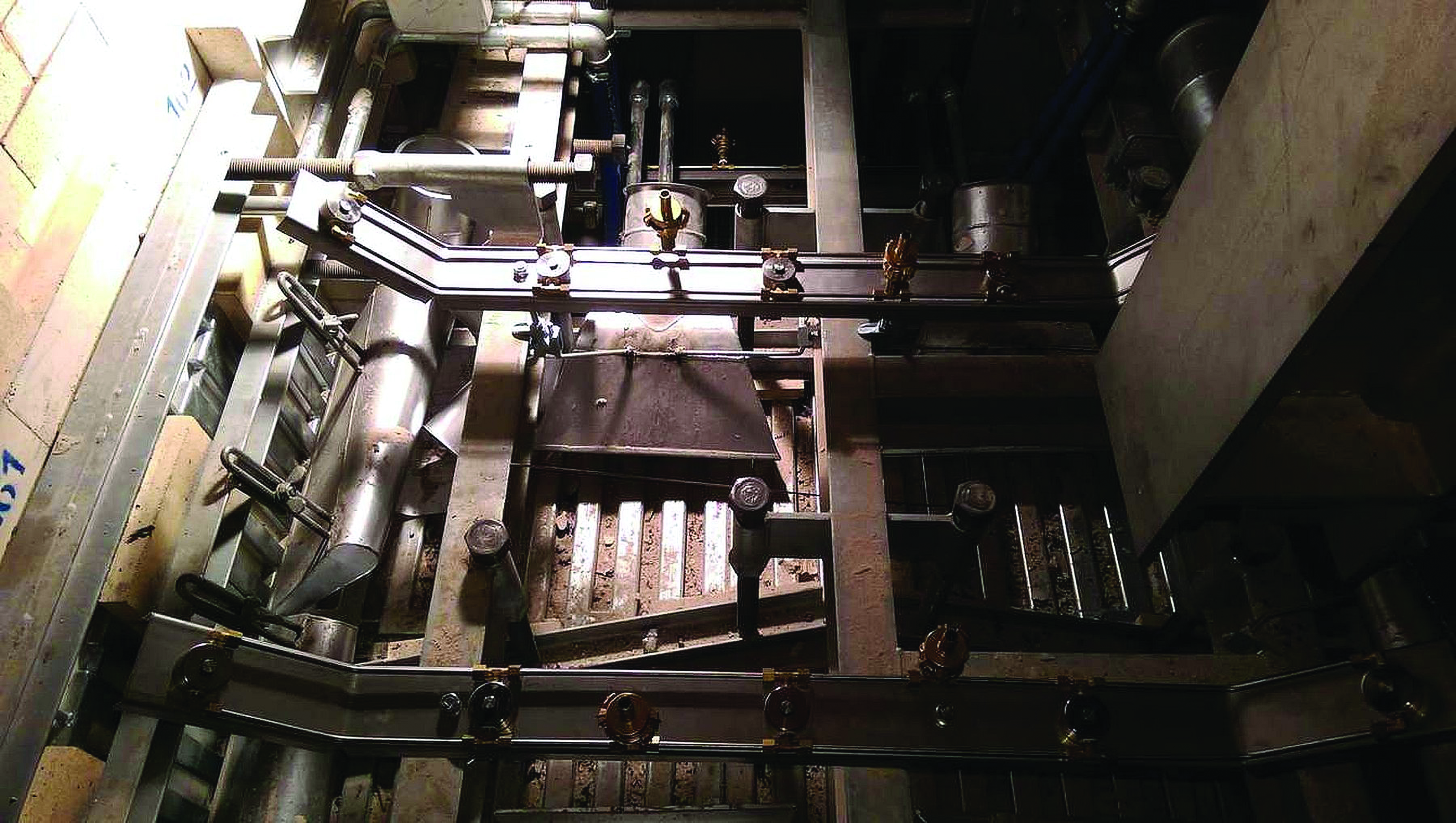Throughout the glass industry, water cooling is used when an intense cooling effect is required. It enables, for example, the use of batch charging machines with pushers that plunge into the glass. For electrode holders, which are inserted through the refractory of the furnace side walls or the furnace bottom to supply electric boosting, water cooling is mandatory.
Beyond these common cases, SORG has recently noticed an increase in interest for ‘unusual’ applications of water cooling around glass melting furnaces. To enable these possibilities, the company has looked deeply into the thermodynamics of such water-cooled furnace equipment. Correct material selection is a key factor in the design of such equipment. This choice depends on the installation location, expected stress and possible corrosive attack by the surrounding atmosphere. Another crucial point for the safe operation of water-cooled equipment is the quality (chemical and physical composition, temperature) and uninterrupted supply of cooling water.
Water cooling can pose an additional risk for the safety of the plant and operators. Hot water and steam can form when the cooling water supply fails or is stopped for maintenance. If the furnace is equipped with electric boosting, water-cooled equipment parts can pick up dangerous voltage or can be destroyed by earth current. To reduce these hazards, SORG has executed a conformity evaluation and risk assessment. Together with every piece of water-cooled equipment, a comprehensive user manual is supplied.
Hereafter, some examples for recently realised projects are named. A multitude of further applications for water cooling are possible and can be investigated and dimensioned, on request.
Throat cooling registers and spray cooling
Melting furnaces for special glasses often have very limited space around the throat. Intense air cooling of this area, which is exposed to high wear, further aggravates the space problems, restricts visibility and therefore increases the risk of glass leakage. By installing cooling registers on the throat cover, part of the cooling effect can be provided by water. Due to the special design, simultaneous air cooling is possible and the refractory beneath the registers remains visible for continuous inspection.
In cases of extreme refractory corrosion and/or the need to have a high cooling capacity, direct water cooling can be installed. This direct cooling uses the latent heat of vapourisation. Problematic in this case is the fact that a small amount of water is sufficient to achieve the desired cooling. This small quantity needs to be evenly spread out on a big surface area. Furthermore, the cooling effect needs to be finely adjustable. Atomisation of the cooling water with compressed air enables this application.
Superstructure supports
Due to longer and longer furnace campaigns and the trend towards intermediate cold repairs, demand for more and increasingly complex hot repairs is growing. In this specific case, the throat gable wall of an end-fired furnace started tilting and collapsed partly. To stabilise the superstructure until material and staff for the hot repair (replacement of the gable wall) were organised, the superstructure was secured by water-cooled pins and hooks. This prevented the gable wall from complete collapse.
Water-cooled sealing plates for gas burners
Among other things, a stable flame formation is important for the emissions of gas-heated furnaces. This requires suitable burner block geometry but burner blocks are heavily loaded by extreme temperature changes and evaporation from the melt and therefore, wear quickly. By the application of water-cooled sealing plates, a part of the burner block geometry is formed by the long-lasting steel sealing plate. Furthermore, water cooling reduces the temperature at the burner block, which further prevents premature corrosion.
Regenerator bottom cooling
In the practical example, a float glass furnace is installed in an area of high groundwater level. During furnace reconstruction, the leaky concrete foundation in the deep basement was sealed by the injection of synthetic resin with a maximum temperature rating of 50°C. A classical refractory design for the bottom of the regenerators and flue gas channels would have led to higher temperatures at the building foundation. This problem was solved by laying water-cooled steel pipes in the bottom of regenerators and flue gas channels on an area of nearly 600m² to dissipate the remaining energy that is transferred through the already optimised refractory layers. Dimensioning of this water cooling with its complex arrangement of refractory materials and different thermal conductivities was a result of mathematical modelling.
SORG can supply the complete spectrum of water cooling systems, including:
• Cooling water supply (tailor-made water treatment, pumping skids, re-cooling plants of any kind, distributor skids with flow and temperature monitoring).
• Dimensioning of water-cooled furnace equipment, as shown in the examples described above.
• Manufacturing of these equipment parts from suitable material and to highest quality demands.
• Documentation for all equipment parts.
• Service in case of outage or leakages, eg due to the loss of cooling water supply or insufficient cooling water quality.


